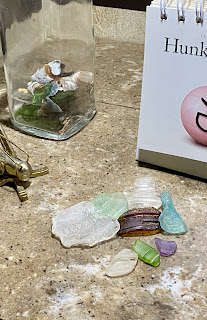I give it three stars.
This delicate periwinkle flower, chicory, grows wild along the roadsides on tall, thin stems. It is a beauty and it is ubiquitous. Chicory, however, is also grown commercially. The roots are baked and ground, then can be used as a coffee substitute or an additive to coffee. Coffee made with chicory is more common in the southern states than the northern. The largest producer of chicory in the United States is in Nebraska.

The Sunflower Festival in Mountain City, Tennessee.
Yes!
Festivals are still occurring in Northeastern Tennessee, but on a much smaller scale.
Sycamore Shoals Historic State Park
Elizabethton, Tennessee
In 1772, the leaders of the settlement around Sycamore Shoals came together to establish, "the first free and independent community on the continent," four years prior to the signing of the Declaration of Independence.
In 1780, Sycamore Shoals was the muster site of the Overmountain Men. The Overmountain Men were frontiersmen from west of the Appalachian Mountains who took part in the Revolutionary War. These Tennesseans were rebels even back then. King George III had declared it unlawful for anyone to live west of the Appalachian Mountains.
The park features a 1.2 mile hiking trail on the south bank of the Watauga River.
These two pictures are of the Carter Mansion and family cemetery. John Carter was one of the primary leaders of the settlement in 1772. He and his son, Landon, who served in the Revolutionary War at the age of 16, built their home between 1775 and 1780 three miles from Sycamore Shoals. This structure is the oldest standing frame house in Tennessee. The county where this house and cemetery are located was named after the Carter family in 1796. The town of Elizabethton was named for Landon's wife, Elizabeth.
 |
| This is the path we hiked. Notice how level it is. There was NO climbing involved. |
 |
Fly fishing. Sycamore Shoals is on the south bank of the Watauga River. On the north bank is an RV park.
|
Additional Notes:
I have learned to make scones!
I am both charmed and captivated by colored glass. I absolutely love finding sea glass. Sea glass is weathered glass found on beaches along bodies of salt water. The weathering process produces naturally frosted glass. Sea glass takes 20 to 40 years, sometimes as long as 100 years, to acquire its characteristic texture and shape.
Living in Oklahoma doesn't provide much opportunity to pick up sea glass. When I lived in Broken Arrow, each day I would take the dogs for a long walk. While the dogs were occupied sniffing, I was picking up what I fondly refer to as gutter glass. Gutter glass would be the bits of broken glass one finds littered in parking lots and along the curb in the gutter. Think what you will, but I always felt I was performing a community service by picking up the sharp, broken glass while all the time pursuing my favorite hobby of collecting colored glass.
The photo above shows the glass I've found on the beach of the creek. Beach glass comes from fresh water and has a less frosted appearance than sea glass. Note the piece of purple beach glass. That color is a very rare find!
Each night as I go to sleep, I am treated to a myriad of fireflies that I can see from the window beside my bed. It is an extraordinary show of exceptional beauty. (The photo is not my own. Try as I might, I could not get a useable picture. This picture is from a news article alerting Tenneesseeans to the arrival of hundreds of fireflies in the Smoky Mountains. The Firefly Festival was, of course, cancelled.)
I've started rereading Cold Mountain by Charles Frazier, a native North Carolinian. The actual Cold Mountain is about 3.5 hours south of where we're parked. Sadly, we will not be able to work in a visit to Cold Mountain this year. However, reading the book Cold Mountain while parked in the Appalachian Mountains has brought all that I am seeing down to a more personal level. It has given a voice, although fictional, to the monuments and historical sites we have viewed.
This is how I imagined it would be and I am so very grateful. ~Mrs. M, The Magpie Flies













2 comments:
What beautiful pictures accompanied by a great narrative.
Love you,
Mom
Thanks,Mom. Miss you!
Post a Comment